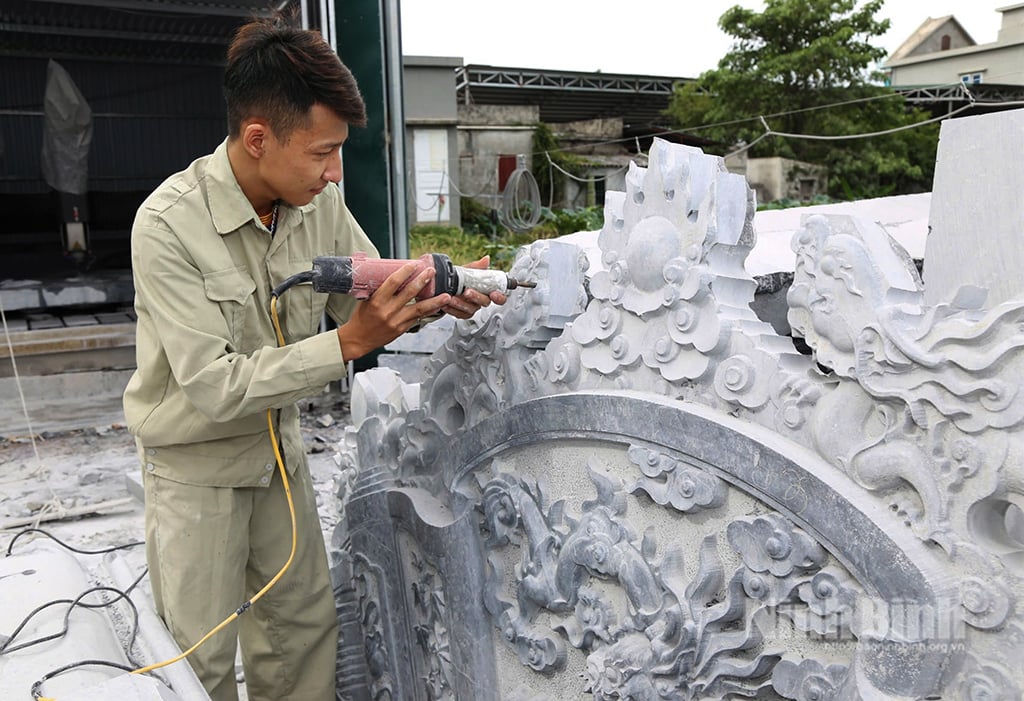
At nearly 30 years old, Mr. Duong Minh Trung has become the owner of a famous stone carving business in Ninh Van commune (Hoa Lu city). Mr. Trung received the "Golden Hand" award for Ninh Binh stone carving in 2020. Despite his good skills, Mr. Trung still highly appreciates the stone carving vocational classes organized by the locality in collaboration with vocational training institutions for stone workers.
Mr. Trung shared that most stone workers in Ninh Van know and practice stone making from a very young age in the form of “father to son”, but not everyone grasps the basic principles of painting, sculpture, etc.
Besides, nowadays, many machines have replaced human labor. However, to use these devices safely and effectively, not all workers have in-depth knowledge. If workers are not familiar with how to use the equipment safely, it will not only affect the quality and aesthetics of the product, but worse, workers may encounter risks during the work process.
“Not only that, when participating in the vocational class, students are also instructed on how to sit and hold tools correctly according to standards instead of “sitting anywhere” like before. Just sitting in the right position will help the worker be less tired and create balance in each carving line. After being trained, workers will have basic knowledge, high skills, and be ready to carry out orders that require high sophistication with a commensurate profit level,” said Mr. Trung.
Mr. Do Khac The, a famous stonemason in Ninh Van, shared: In practice, the biggest weakness of Ninh Van stonemason is their limited drawing ability. Therefore, when starting to craft, the product can be unbalanced, greatly affecting the aesthetics. There is still a lot of knowledge that needs to be learned if the village's products are to be brought to the large market, so when the locality coordinated to organize training courses on sculpture, the households in the area actively participated.
Basically, workers in Ninh Van stone craft village have good technical foundation, passion for the job and are rich in creativity. However, to create a beautiful product, only skillful and skillful hands are not enough, but also require the craftsman to have basic and comprehensive knowledge and skills in each stage of the process of making the work.
However, similar to the situation of most other craft village workers, due to learning and teaching the craft in the style of “hand-holding” and “father-to-son” from generation to generation, many workers have not yet had access to the basic skills and knowledge of the sculpture profession. Many craft villages can only make one main type of product such as: flowers, animals or statues...
Having directly participated in vocational training for workers in Ninh Van stone craft village, teacher Tran Phu Thuan, Deputy Head of Vocational Training Department, Nam Dinh Construction College shared: When learning a trade, learners will be equipped with knowledge to be able to make all products according to changing customer tastes. Learners are also trained in how to choose stone materials, know how to use safe machines and especially learn about product orientation. With this subject, learners can determine tastes to plan the production of each type of suitable product.
Dong Huong Commune (Kim Son District) is one of the localities with a large area of agricultural land being reclaimed to build Dong Huong Industrial Cluster. In addition to coordinating with businesses, providing vocational training and creating jobs for about 700 local workers, Dong Huong Commune also focuses on and strongly develops handicraft villages, namely Dong Dac and Huong Dao.
In order to attract rural workers to work in craft villages, the commune's organizations and unions have actively participated and persistently encouraged workers, especially those over 40 years old, to learn a trade. During the learning process, people are not only guided by artisans to improve their craft skills but also updated with new designs that suit consumer tastes and especially meet the requirements of export enterprises.
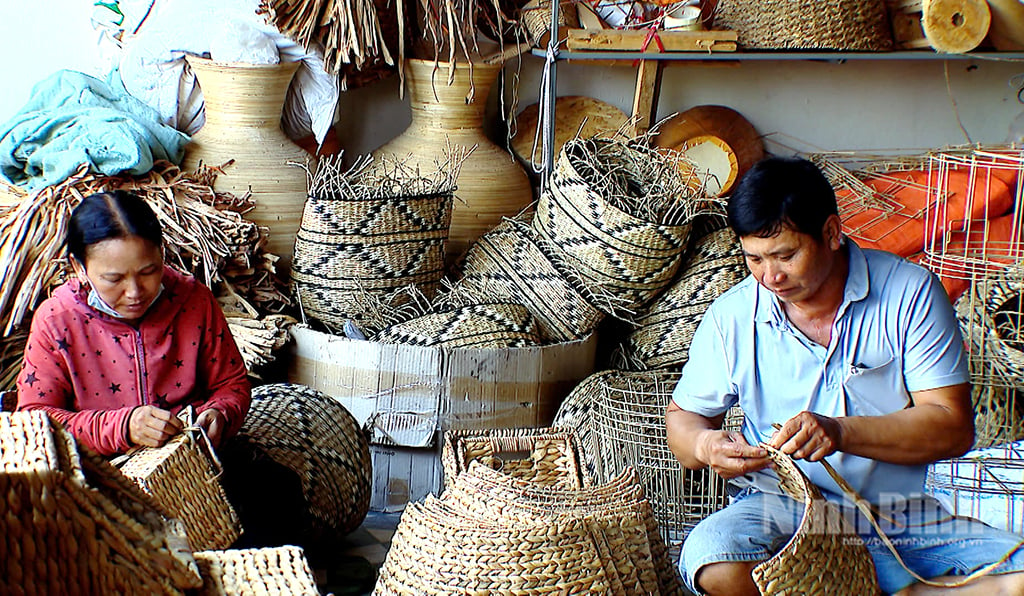
Every year, Dong Huong commune coordinates to open vocational training classes for rural workers, in which there is a clear distinction between those who already know the profession for advanced training and those who do not know the profession for new training. Therefore, the quality of the classes always meets the requirements.
Although weaving sedge and water fern in Dong Huong is a sideline job, it has become the main source of income for the people in the commune. Currently, the craft village has nearly 400 regular workers with the lowest income of 3 million VND/person/month. These are workers who are not within the recruitment age of businesses.
The Viet Xo Construction Electromechanical College is one of the province's vocational training institutions that actively provides vocational training for workers in craft villages. Mr. Nguyen Hong Phong, Vice Principal of the school, said that the school also regularly coordinates with localities in the province to organize on-site vocational training classes for workers in craft villages. Participants in this vocational training class are all workers who already know the trade. Not only fostering vocational skills, the school also equips students with knowledge in calculating raw materials, understanding of the product consumption market; knowledge of preventing occupational accidents and diseases; advanced training to aim at making highly sophisticated products...
At the end of the vocational training course, workers are granted a vocational training certificate. With this certificate, they will have the opportunity to access bank capital and participate in the high-quality labor market. In particular, after completing the elementary vocational level, students, if needed, will be accepted by the school for training at the intermediate and college levels to obtain high-level skills, meeting the increasingly demanding market.
According to statistics from the functional sector, in Ninh Binh province there are 77 craft villages recognized by the Provincial People's Committee, most of which are craft villages producing handicrafts such as: stone carving, embroidery, sedge, rattan weaving, carpentry, ceramics... requiring high skills.
In recent years, along with promoting vocational training for rural workers, functional sectors and localities have also paid great attention to vocational training for workers in craft villages. With high skills, in line with the trend, workers will achieve better income for the same unit of product.
In addition, with a workforce that is both "specialized" and "elite", it also contributes to preserving and developing traditional professions, preserving the cultural quintessence of the homeland.
Source: https://baoninhbinh.org.vn/chat-luong-lao-dong-lang-nghe-can-chuyen-va-tinh-418358.htm


















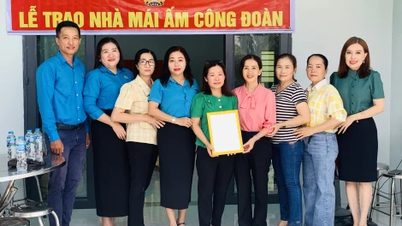





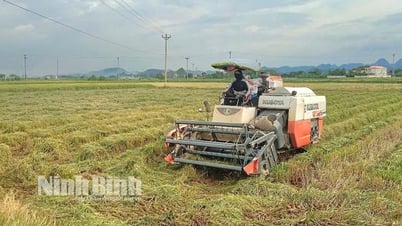



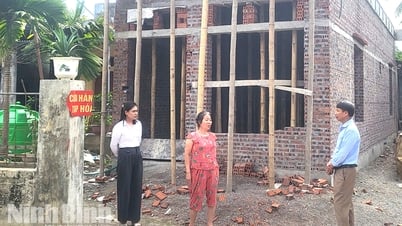




































































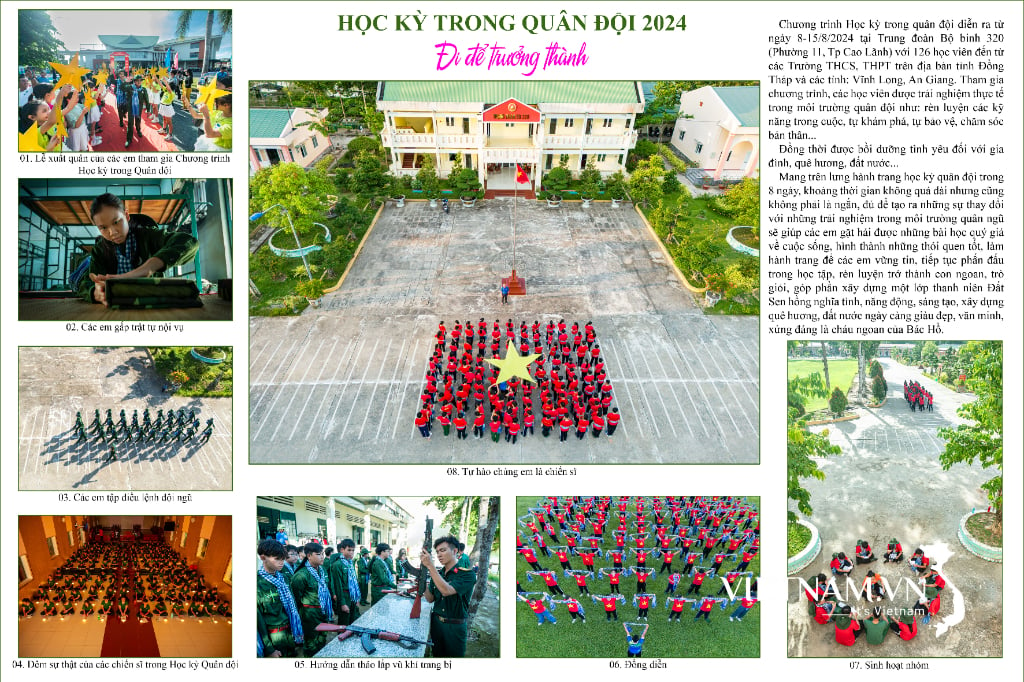

Comment (0)